Talking Turkey
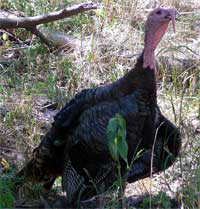 Marion Maxwell has come up with a treasure trove of turkey facts – and an unusual cooking method for the big bird...
Marion Maxwell has come up with a treasure trove of turkey facts – and an unusual cooking method for the big bird...
What is gallopavophagy? Is it true that French peasants liked to eat Jesuits? Why can the turkeycock no longer perform its time-honoured function of tramping the hen? Before the coming of the railways, what were turkeys' shoes made of?
For the answer to these questions and many more, read on and savour some seasonal gobbledegook. Whether for the office party, the local table quiz, or that lull between the present opening and the arrival of the object in question, ‘that big dead thing in the middle’- the turkey, here are some indispensable gems of turkey trivia to trot out at the opportune moment.
Gallopavophagy: that's what most of us - about 77% nationally or 82% of socio-economic group A/B - will be doing on Christmas Day. It means "turkey-eating" and owes its origins not, as you might think, to the noise the creature makes but to the name given to the species: gallo or 'chicken' and pavo or 'peacock'.
The 'turkey' is actually a native of North America. Wild turkeys lived in woods and ate maize, fruit and grass. North American Indians hunted them for food and used the feathers to decorate their headdresses, but it was the Mexican Aztecs who were responsible for domesticating them. 'Mole Poblano', the famous Mexican turkey dish, contains chocolate as well as chillis, nuts and spices.
This is a bird that has suffered historically from an identity crisis. All the names by which the bird is known in Europe are based on misapprehensions as to its origins.
It was called the 'turkie-cock' because it arrived in Europe via Spanish ports on the boats of Turkish traders who used Seville as a port of call between the Spanish Colonies and Eastern Europe.
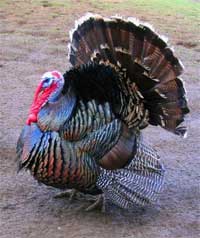 The French and Germans refer to it as the Indian hen ('dindon' or 'indianische Henne') just as, irony of ironies, do the Turks themselves ('hindi’). This tradition probably has its origins in the fact that the bird is known to have been brought to India in the 1820's from the Phillipines, then a Spanish possession governed from Mexico.
The French and Germans refer to it as the Indian hen ('dindon' or 'indianische Henne') just as, irony of ironies, do the Turks themselves ('hindi’). This tradition probably has its origins in the fact that the bird is known to have been brought to India in the 1820's from the Phillipines, then a Spanish possession governed from Mexico.
Rural France throws up yet another variation. There, the turkey became known as 'le Jesuit', named for the Jesuit missionaries who introduced it there.
The first 'turkeys' to arrive in Britain in the early 16th century were often confused with guinea-fowl, probably because, although larger, they were also scrawny and dark-feathered. A turkey was sometimes used instead of a swan for a dramatic centrepiece at the Christmas feast in great country houses, but not till much later did it replace the goose as the favourite festive bird.
The biggest market worldwide for turkey is the U.S.A., where it has always been the centrepiece of the Thanksgiving Dinner. Ironically, the American breeds are based not directly on the native wild turkeys but on the birds that had been brought to England, developed and improved there by experienced Norfolk poultry breeders and then brought back by settlers to New England, all this not much more than a century after the Colombian voyages.
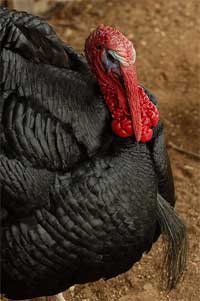 Norfolk was the main centre for turkey breeding in Britain from the 17th century and the 'black Norfolk' was particularly prized. An expensive luxury, the birds had their feet fitted with small leather boots or a coating of tar for their 100 mile walk to the London markets.
Norfolk was the main centre for turkey breeding in Britain from the 17th century and the 'black Norfolk' was particularly prized. An expensive luxury, the birds had their feet fitted with small leather boots or a coating of tar for their 100 mile walk to the London markets.
The famous Yorkshire Christmas Pies, an invention of the 18th century, were another Christmas luxury, this time transported in boxes to London. Inside a huge 'standing' pastry case was packed a boned turkey, inside which was a goose, stuffed in turn with a chicken in which was a partridge, inside which again was a pigeon. Portions of hare and other game were packed in around the sides and finally about four pounds of butter were packed in under a pastry lid before baking.
In the 19th century, birds imported from Ireland played their part in spreading the turkey habit one notch down the social scale to the professional classes in mainland Britain, but it wasn't until well into the 1950’s that most ordinary town-dwellers could put a turkey on the Christmas table. It was factory farming methods, and freezing techniques developed in the 50's and 60's, which finally brought turkey eating within reach of most people and turned the bird into a year-round commodity.
Breeding and fattening are now two distinct occupations. In the industry, turkeys have been bred to put on weight as quickly and cheaply as possible. For this reason, the fleshy white turkey has largely replaced the older, gamier-tasting, small-breasted black and bronze breeds. In addition, it was found that many customers disliked the dark pen feathers that speckle the carcass of the darker birds. [Although the trend is now showing signs of reversal, with the revival of interest in rare breeds and small scale production (Ed).]
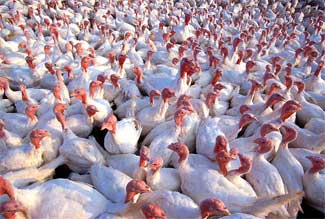 In the traditional domestic setting, the farmer's wife would take her turkey hens in a basket to a neighbour's turkeycock to have them 'tramped'. All eggs are fertilised at the one mating and a turkey hen would, on average, lay 10-12 eggs. However, in the quest to produce meaty birds, the turkey cocks or 'stags' have been bred to be big-breasted rather than stud-like. As a result, they are too ungainly to copulate in the normal way and tend to fall off the female's back. The result? Turkeys now have to be bred by artificial insemination. According to the natural order of things, turkey eggs would be hatched in February or March and it then takes about nine months for the free-ranging young birds to mature. However, with the development of fast-growing strains and growth-promoting feedstuffs, turkeys can now be ready in less than half the time, so that it is possible to rear two batches in the year.
In the traditional domestic setting, the farmer's wife would take her turkey hens in a basket to a neighbour's turkeycock to have them 'tramped'. All eggs are fertilised at the one mating and a turkey hen would, on average, lay 10-12 eggs. However, in the quest to produce meaty birds, the turkey cocks or 'stags' have been bred to be big-breasted rather than stud-like. As a result, they are too ungainly to copulate in the normal way and tend to fall off the female's back. The result? Turkeys now have to be bred by artificial insemination. According to the natural order of things, turkey eggs would be hatched in February or March and it then takes about nine months for the free-ranging young birds to mature. However, with the development of fast-growing strains and growth-promoting feedstuffs, turkeys can now be ready in less than half the time, so that it is possible to rear two batches in the year.
Turkeys are highly strung and not noted for their intelligence. A loud noise will stampede them into a corner and in a panic they can suffocate each other. The fact that they are shy, reluctant feeders is another reason why they are notoriously hard to rear.
Turkeys are susceptible to the 'pip' or the 'roup', that is, worms in the windpipe. The old remedy was to feed them chopped nettles in their oatmeal, but modern commercial feedstuffs are treated with antibiotics that prevent such ailments.
Traditionally, turkeys are hung for at least 10 days to enhance the taste. Where mass production methods are used, however, they are plucked and cleaned out by machine and, once this is done, they cannot be hung because bacteria thrive in the empty carcass.
According to the Guinness Book of Records, Vincent Pilkington from Cootehill in Co. Cavan killed and plucked 100 turkeys in 7 hours 32 minutes on 15th December, 1978. In 1980, live on R.T.E's Late Late Show, he plucked a turkey in 1 minute 30 seconds. His record still stands.
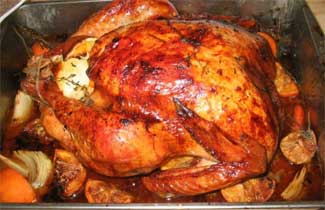 The reason turkeys have white and dark meat is to do with lifestyle. Turkeys tend to do a lot of standing around and thus the most active muscles such as legs and thighs require more blood vessels containing 'myoglobin' which delivers oxygen to the muscles. This is what makes the leg and thigh flesh end up darker. (All the flesh of game birds is dark for this reason). White meat is the result of well-rested muscles and since turkeys do little or no flying, there is no need for a rich supply of oxygen to the pectoral muscles and thus breast meat remains pale.
The reason turkeys have white and dark meat is to do with lifestyle. Turkeys tend to do a lot of standing around and thus the most active muscles such as legs and thighs require more blood vessels containing 'myoglobin' which delivers oxygen to the muscles. This is what makes the leg and thigh flesh end up darker. (All the flesh of game birds is dark for this reason). White meat is the result of well-rested muscles and since turkeys do little or no flying, there is no need for a rich supply of oxygen to the pectoral muscles and thus breast meat remains pale.
For the luxury end of the market, many breeders are now bringing back the older breeds and also answering the demand for organically produced meat. The most sought-after turkey now will be free range, grown slowly to full maturity, fattened on food containing no animal protein and at least 70% cereal, reared without the use of any antibiotics or growth-promoting additives, hand-plucked and hung traditionally for 10 days or more. Generally, well-exercised, tough meat is tastier than tenderer, less-exercised meats Leg or breast. Sir?
In sweet muslin dres't
Having created the demand for big birds with plenty of breast meat (I hope you're feeling suitably sorry for the poor stag turkey) we devote a lot of our attention, when it comes to cooking the bird, to making it as moist as possible.
In case you haven't had the nerve to try out cooking your turkey in muslin, here's how. You just have to take my word that it works the first time you do it. You'll die of shock when you take the mummified object out of the oven, but just wait till you see what awaits you inside. Don't have the oven too hot, that's the only thing, or you could end up with a charred mess!
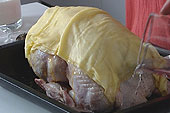 For a 12-14 lb turkey take a double thickness of butter muslin, 30 inch square. Place turkey, breast uppermost, in the middle of the square. Season generously inside and out with salt and black pepper. Put two peeled carrots, a sliced onion, a quartered apple and a bunch of parsley in the cavity, with a pound of butter. Smear another pound all over the skin — don't neglect the thighs. Draw up muslin, fold over a seam and fasten with cocktail sticks, anchoring them into the bird as well, until bird is totally enveloped. Cook the bird in the roasting tin, not on a rack, according to your usual timetable (no need to baste). When done, leave to rest for 10 minutes before removing the muslin.
For a 12-14 lb turkey take a double thickness of butter muslin, 30 inch square. Place turkey, breast uppermost, in the middle of the square. Season generously inside and out with salt and black pepper. Put two peeled carrots, a sliced onion, a quartered apple and a bunch of parsley in the cavity, with a pound of butter. Smear another pound all over the skin — don't neglect the thighs. Draw up muslin, fold over a seam and fasten with cocktail sticks, anchoring them into the bird as well, until bird is totally enveloped. Cook the bird in the roasting tin, not on a rack, according to your usual timetable (no need to baste). When done, leave to rest for 10 minutes before removing the muslin.





There are currently no comments
Leave a comment
Not a member? Register for your free membership now!
Or leave a comment by logging in with: